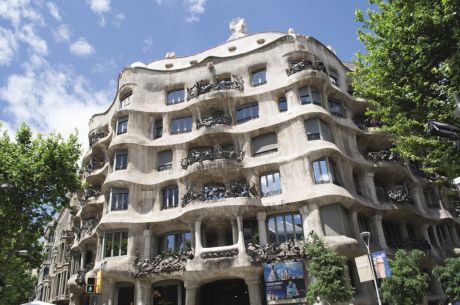Many say that Barcelona’s the coolest city in Europe, and it’s easy to understand why: this town has incredible nightlife, great food, and an amazing art scene. You can admire legendary architect Antoni Gaudí’s insane-looking buildings while you taste your way through a tapas crawl—Barcelona is famous for these small plates and the bar-restaurant hybrids that serve ’em. Or maybe take part in one of the many rowdy street festivals (such as La Mercé, held every September). Whatever you do, make sure to leave yourself plenty of time to just wander; you’ll discover a friendly city where centuries-old traditions cross paths with avant garde culture.
The easiest way to move around Barcelona is either on foot or by metro. Regarding the latter, don’t bother with the day tickets—get a T-10 (10 single tickets card), as it’ll save you some time and hassle. Start your first day as a real Barcelonian does, and get your breakfast in a food market. Head off to Mercat de la Boqueria (Rambla de Sant Josep, 91), and bypass the stalls at the front, which sell mainly fruit shakes. Copy the cheeky fishmongers in the central aisle and have a proper breakfast at one of the market’s bars, such as Pinotxo (Boqueria Market, Stall 466). You may have to wait or jostle for a stool, but be patient and you’ll enjoy delicacies such as an artichoke omelette or cap i pota, the local version of tripe, while the waiters banter with you in broken English.

Now that you’re ready to face Barcelona’s bustling streets, head to Plaça Sant Jaume. It’s in the oldest part of town, and you can stroll the nearby rambling medieval alleys of the Barri Gòtic (Gothic Quarter). Stop by Caelum (Calle Palla, 8), a shop located in a former Jewish bathhouse that specializes in sweets and pastries made by nuns in Spanish convents. Then walk down the Passeig de Gràcia—while this avenue is one of the fanciest in the city, viewing the stunning facades of Gaudí’s Casa Batlló (Passeig de Gràcia, 43) and La Pedrera (Carrer de Provença, 261) won’t cost you a penny. You can visit the interior of both, but if you’d like to decorate your own place, pick up some classy housewares at Vinçon (Passeig de Gràcia, 96). Then walk 15 minutes north into the Gràcia neighborhood. Gràcia wasn’t a part of Barcelona until 1897, and the arty crowd loves its boho vibe. Visit Plaça del Diamant (Carrer d’Astúries), a small square where the novel The Time of the Doves, considered a masterwork of Catalan literature, takes place. The La Colometa sculpture inside is named after the novel’s protagonist, one of author Mercé Rodoreda’s most memorable creations. Grab a quick snack in any of the area’s cafés, and wash it down with a fancy gin and tonic (or three) at Heliogàbal (Ramón y Cajal, 80), Barcelona’s current hipster bar of choice.

The next morning, head to Plaça Espanya (at the junction of Gran Via de les Corts Catalanes and Carrer de Tarragona), where you can start your trek to Montjuïc, one of the city’s biggest green spaces. Stop on the way at Caixaforum (Av. De Francesc Ferrer i Guàrdia, 6-8), a factory-turned-arts-center, and then at the MNAC (Palau Nacional, Parc de Montjuïc), a museum that hosts a world-class collection of paintings. Don’t forget to look down onto the city from the entrance: the view will take your breath away. You can also visit Poble Espanyol (Avinguda Francesc Ferrer i Guardia, 13), a quaint open-air village/museum featuring full-size reproductions of some well-known Spanish landmarks.
For more outdoor fun, head to the Barceloneta district, by the sea. Stroll by the waterfront and have a swim or un vermut (the Catalan way of referring to both an aperitif drink and a relaxed tapas lunch) at one of the places around nearby square Plaça de la Font. Afterward, buy dessert at the bakery Baluard (Carrer del Baluart 38-40), owned by Anna Bellsolà, one of Spain’s best-known bakers. Or go to Bar Leo (Sant Carles, 34) for a laid-back drink and a taste of Barcelona at its least gentrified. Leo, the owner, has been working at this lovely dive since she was a teen, and it’s a de facto temple to flamenco singer Bambino. On weekend afternoons, you’ll find everyone from punks to fishermen listening to the bar’s battered jukebox.
After a few drinks, stroll north into El Born, a hip neighborhood whose narrow medieval-era streets are full of design shops and gastrobars. Visit the serene and beautiful Santa Maria del Mar church (Plaça de Santa Maria, 1) before stopping by the Centre de Cultura de Dones Francesca Bonnemaison, (Carrer de Sant Pere Més Baix, 7), a women’s cultural center created by early 20th-century feminist Francesca Bonnemaison. Its library hosts a huge trove of lady-centric materials, many of them dating from before Spain’s civil war in the 1930s. Before you leave El Born, browse the craft and sewing supplies from the adorable boutique El Calaix (Carrer de l’Esquirol, 4) or grab a bright, inexpensive dress by female design duo Bartomeu i Uribe at their atelier (Carrer dels Carders, 31).

In the evening, explore the Poble Sec district, a diverse ’hood with a bustling street scene. Sip craft beers and try some artisan cheeses at Celler de Cal Marino (Carrer de Margarit, 54), before dancing the night away at Apolo (Carrer Nou de la Rambla, 113), a club that also serves as a concert venue. Check the listings in advance, as its schedule changes constantly—just like Barcelona does.
By Mar Calpena
Photography by Gaston Bertin

This review appears in the Aug/Sept 2013 issue of BUST Magazine with Janelle Monáe. Subscribe now.


